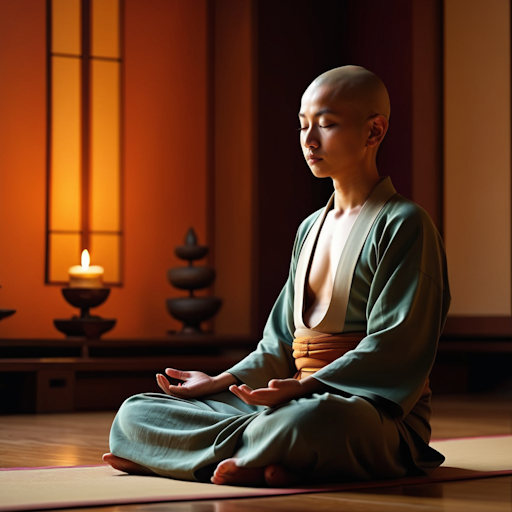Zen Buddhism, often referred to simply as Zen, is a school of Buddhism that places a profound emphasis on meditation as a means of attaining spiritual insight and awakening. Zen meditation techniques are renowned for their simplicity and effectiveness in helping individuals connect with their true nature and find enlightenment. In this article, we will explore three core meditation techniques in Zen Buddhism: Zazen (seated meditation), Koan meditation, and Walking meditation (Kinhin). Additionally, we will delve into the many benefits that can be reaped from a regular meditation practice.
Zazen (Seated Meditation)
Zazen, or seated meditation, is the most foundational and widely practiced of all Zen meditation techniques. It involves sitting in a specific posture with mindfulness, concentrating on the breath, and observing the thoughts without attachment. The posture itself is essential in Zazen as it provides stability and comfort, allowing the meditator to focus their mind.

The key elements of Zazen practice include:
- Posture: The meditator typically sits on a cushion (zafu) with their legs crossed (full lotus or half-lotus) and spine straight. The hands form a specific mudra, with the right hand resting on the left, thumbs lightly touching, and palms up.
- Breath awareness: In Zazen, the breath becomes the primary point of focus. Meditators observe the natural rhythm of their breathing without attempting to control it. This mindfulness of breath helps to calm the mind and anchor awareness to the present moment.
- Observing thoughts: Rather than suppressing or engaging with thoughts, Zazen encourages meditators to simply observe them without judgment. By acknowledging thoughts and letting them pass, one can cultivate a sense of detachment.
Zazen is a transformative practice that encourages self-discovery and the realization of one’s true nature. It is often said in Zen that “sitting silently, doing nothing, spring comes, and the grass grows by itself,” reflecting the profound simplicity of Zazen.
Koan Meditation
Koan meditation is a distinctive and enigmatic form of Zen meditation. A koan is a paradoxical statement or question that lacks a rational answer and is used to challenge a practitioner’s logical mind. Meditators engage with a koan in a way that goes beyond conventional thinking and encourages a direct experience of truth.

Here are some aspects of Koan meditation:
- The role of the koan: A koan serves as a tool to break down conceptual thinking and provoke insight. Common koans include questions like, “What is the sound of one hand clapping?” or statements like, “What is your original face before your parents were born?”
- Meditation with a koan: Meditators engage with a koan by contemplating it deeply. They may focus on the question or phrase, allowing it to permeate their consciousness. The process is not about finding a rational answer but rather about transcending ordinary thought.
- The breakthrough moment: Through sustained inquiry into a koan, meditators may experience a profound insight or a shift in consciousness. This “aha” moment is considered a breakthrough and a step towards enlightenment.
Koan meditation is a method that challenges the intellect and invites meditators to go beyond conventional logic, aiming to awaken a direct and intuitive understanding of reality.
Walking Meditation (Kinhin)
In addition to seated meditation, Zen practitioners often incorporate walking meditation, known as Kinhin, into their practice. Kinhin involves walking mindfully, often in a circle, while paying full attention to each step and the breath. It serves as a way to bring the benefits of meditation into motion.

Key aspects of Kinhin include:
- Mindful walking: In Kinhin, every step is taken with full awareness. The pace is typically slow and deliberate, allowing meditators to synchronize their breath with each step.
- Silent concentration: Participants walk in a line or a circle, maintaining silence to enhance their concentration. The focus is on the act of walking and breathing.
- Integration with Zazen: Kinhin is often practiced in between sessions of Zazen, serving as a way to maintain mindfulness during everyday activities.
Kinhin is not only a form of meditation but also a way to extend the meditative state into daily life. It cultivates a strong connection to the present moment and heightens awareness of our surroundings.
Benefits of Regular Meditation Practice
Engaging in Zen meditation techniques can yield a myriad of benefits for practitioners. These benefits extend beyond the realm of spiritual growth and often have a positive impact on mental, emotional, and physical well-being.
Some of the benefits of regular Zen meditation practice include:
- Stress reduction: Meditation techniques like Zazen and Kinhin promote relaxation and mindfulness, leading to reduced stress and anxiety.
- Enhanced concentration: Through focused meditation, practitioners can improve their ability to concentrate and stay present in the moment.
- Greater self-awareness: Meditation encourages self-reflection and self-discovery, deepening one’s understanding of themselves.
- Improved emotional well-being: Zen meditation can help manage emotions, reduce reactivity, and promote a sense of inner peace.
- Increased resilience: Regular practice can enhance one’s ability to cope with life’s challenges and setbacks.
- Spiritual growth: For those on a spiritual journey, Zen meditation techniques can be a path to profound insights and awakening.
- Better physical health: Meditation has been associated with lower blood pressure, improved sleep, and overall physical well-being.
The cumulative effects of meditation practice are often profound and far-reaching, touching all aspects of one’s life.
External Links: